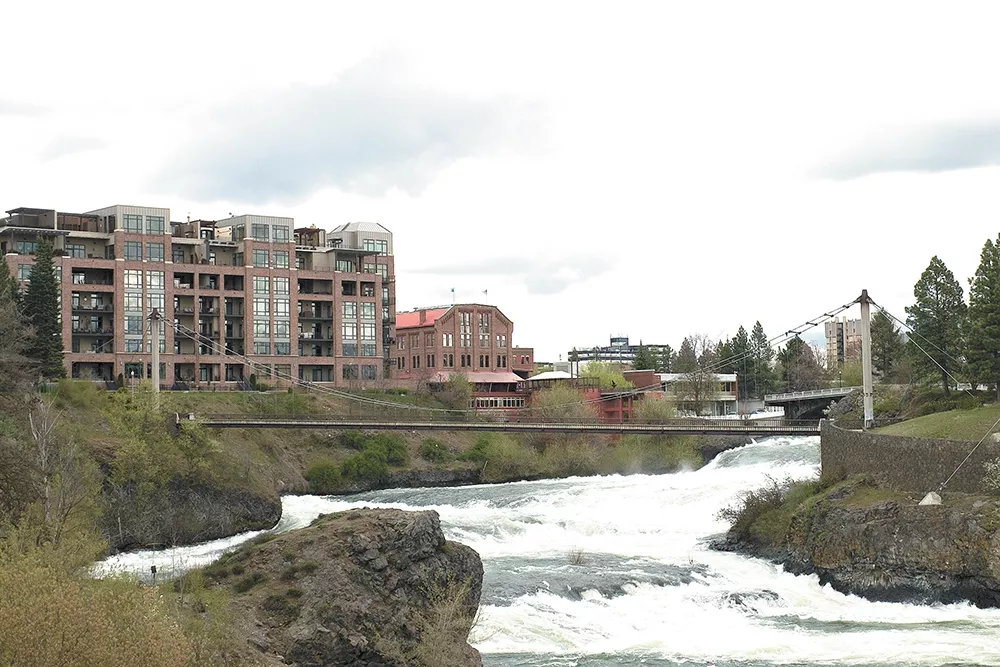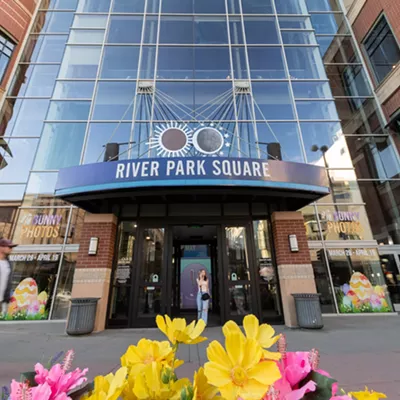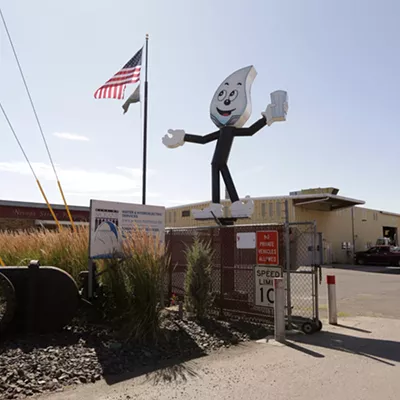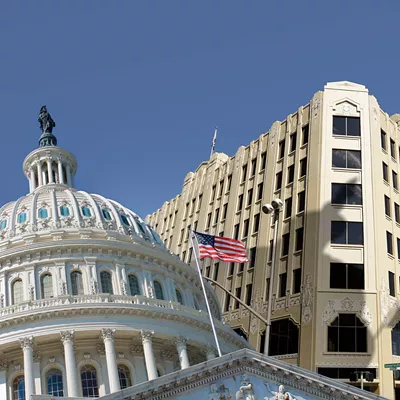
Taken alone, it was a clear victory for the West Central neighborhood. On Monday, the City Council approved $77,000 to renovate the neighborhood's Dutch Jake's Park.
The project had been recommended by the citizen advisory committee overseeing the West Quadrant Tax Increment Finance District. The West Quadrant TIF, for short, was formed to collect some of the extra property-tax revenue sparked by the high-end Kendall Yards development and funnel it toward projects in the surrounding neighborhoods, which have historically been some of the city's poorest.
But not everyone in the West Central neighborhood was happy with the City Council on Monday. After all, the funds directed to Dutch Jake's Park are chump change compared to the amount that the committee recommended for projects in other neighborhoods.
The committee also recommended spending half a million dollars on repairing the crumbling suspension bridge on the western side of Riverfront Park. On Monday, more West Central neighbors spoke out in opposition to spending TIF money on that bridge than they did in favor of approving funds for Dutch Jake's Park.
"To put it bluntly, it's quite offensive to have this money, created by folks who live in one of the poorest neighborhoods ... used for a footbridge that will really not benefit them directly," West Central neighbor Arielle Anderson told the council.
On top of that, the citizens committee recommended giving $511,000, spread across five years, for utility improvements for the Sportsplex that will be built next to the Spokane Arena.
The debate over whether the TIF funds should be used for the suspension bridge and the Sportsplex has pulled in council members, mayoral candidates and even the developer who helped kick off all the new investment to begin with.
"I've been concerned that the money wasn't going where it was originally intended to go," says Kendall Yards' developer Jim Frank. "I felt like West Central didn't have a voice on the committee that was making these decisions."
THE INVESTMENT LOOP
If your eyes glaze over when you hear "tax increment financing," here's a quick explainer: When the Kendall Yards project was proposed, the city anticipated that the new development would result in a dramatic increase in property tax revenues. It wasn't just that turning more than 70 acres of bare dirt near downtown into a residential and business hub would boost the area's value, but that it also had the potential to transform the surrounding area as well.
The TIF, established in 2007, was intended to siphon off part of that extra property tax revenue generated from the new development and channel it into public projects in the nearby West Central, Emerson-Garfield and Riverside neighborhoods. It could be used for things like trail improvements, street upgrades and street lights.
A citizen advisory committee made up of representatives from the three neighborhoods would help the city identify priorities from a list of potential projects.
Ideally, those improvements would spark additional investment, which would mean more tax revenue, which would replenish the TIF's coffers. In the best case scenario, it would be a kind of feedback loop of investment.
And neighborhoods like West Central, Frank says, needed that kind of investment.
"There was disinvestment culture in those neighborhoods," Frank says. "There was capital investment that needed to occur in those neighborhoods that had poverty, but it just wasn't happening."
Some neighborhoods have benefited more than others. The TIF helped fund the Centennial Trail's underpass beneath the Monroe Street Bridge, on the western edge of the Riverside neighborhood. It helped with the North Monroe Corridor improvements in the Emerson-Garfield neighborhood.
But West Central's big priority identified by the TIF committee eight years ago — four blocks of streetscape improvements on Broadway Avenue from Ash to Chestnut streets — never received TIF funding.
"It was probably lack of matching funds," says Andrew Worlock, the former city planner who worked with the committee. Projects need to be shovel-ready before funds are awarded, and in most cases, TIF funding is not enough to finance a project entirely. With few projects available, the citizens committee went effectively dormant for a time.
But lately, there's been a flurry of economic activity in the neighborhoods surrounding Kendall Yards, and a leap in property tax assessments.
"Houses that used to sell for $60 [thousand] are now selling for $100," Frank says.
Today, the TIF funding pool has built up around $900,000. And suddenly, there were multiple projects vying for those funds.
99 PROBLEMS, A BRIDGE JUST ONE
"I was notified by the parks department that the north suspension bridge was crumbling at a faster rate and that it was falling into the river and they would have to close it," says City Councilwoman Candace Mumm. "I was told that the West Quadrant TIF was looking for projects that were shovel-ready."
To Mumm, who also sought funding from the state, it seemed like a perfect match. Technically, the city argued, the bridge could be considered a "pedestrian amenity" covered by the TIF, and to Mumm the bridge had an obvious economic impact.
"It links people to their jobs and to the grocery store," Mumm says. "It will be a direct link to all the expansion in new things opening up on the north side."
But West Central activists like Jessie Norris couldn't help but notice that the suspension bridge and Sportsplex projects both targeted an area that has already seen a lot of investment — including more than $64 million in improvements to Riverfront Park. Norris wrote to City Council members that many West Central residents care more about street improvements or a renovated Broadway business district than a "sports complex hosting events that many of them could never afford to attend."
"Many residents believe that the city isn't really interested in their issues and is unwilling to invest much time or money in the neighborhood," Norris wrote to Councilwoman Mumm. "Whether it's justified or not, I know that there is a lengthy history in West Central of distrust of the city of Spokane."
City Councilwoman Karen Stratton echoed those concerns, arguing spending West Quadrant TIF money on Riverfront Park was inappropriate.
"I live in this neighborhood. It has been ignored, and ignored and ignored, for a very long time," Stratton said at the City Council meeting Monday. "West Central's time has come."
Stratton, along with Councilwoman Kate Burke, voted against the suspension bridge funding. But the rest of the council supported the proposal, and the pedestrian bridge funding was approved.
City Council President Ben Stuckart, a mayoral candidate, says he didn't want to push back against the recommendations from the committee.
"I'm not going to go slamming citizen committees," Stuckart told the Inlander. "If other people wanted to spend those dollars somewhere else, they should have brought forward projects."
Yet, even on that citizens committee, there was division. Committee Chair Kimberly Lawrence says she voted in favor of all three projects as a package, but says she hated spending money on the suspension bridge project.
"The parks department has money," Lawrence says. "West Central doesn't."
Mayoral candidate Kelly Cruz, former chair of the West Central Neighborhood Council, sits on the committee as an alternate and wasn't allowed to vote on it. But he says if he voted, we would have probably opposed it. If he were mayor, he likely wouldn't support it either, he says.
"I would ask for an economic analysis for how it would directly benefit the West Central neighborhood and the Riverside neighborhood," Cruz says. "This is what the money was originally created for ... to increase economic viability. Short of that, I wouldn't support it."
If the council approves funding for the Sportsplex at a later date, it would effectively drain the rest of the TIF funds, possibly forcing future projects to wait until funds get built back up.
Even the committee members who supported spending money on the bridge, however, felt like their options were limited.
"We can only award projects that fall within very specific boundaries and specific improvement areas," says committee member Megan Kennedy, representing the Emerson-Garfield neighborhood.
Assistant City Planner Kevin Freibott, however, says that the TIF committee can influence decisions by recommending the city focus on certain areas or project types within the TIF boundaries. The West Central Neighborhood Council can, too, by applying for traffic calming or other project dollars. But Freibott says that in recent years, West Central hadn't been selected for these projects.
Mumm stresses that the TIF will be active for the next 14 years, plenty of time for projects to be funded in all three neighborhoods. And on all sides, from neighborhood activists to council members, there's agreement on one thing: West Central could use some attention.
"We need to come up with more shovel-ready projects and design them with the neighborhood. I would like to see this money go back into the community as much as possible," Mumm says. "The last thing we want is the neighborhoods to be pitted against each other to compete for project dollars." ♦




















